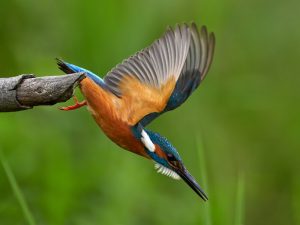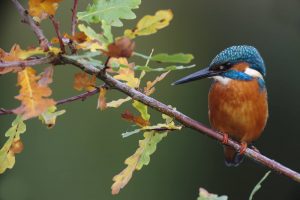I often wish that I lived closer to a river – or had a property grand enough to house a lake – then I would see more kingfishers.
They are delightful small birds, instantly recognisable by their iridescent blue and orange plumage and long, strong beak.
Although they’re one of the most admired birds to reside in much of the UK, they are less likely to be spotted.
Is this due to their small population or, are kingfishers in decline?
Kingfishers aren’t one of the more prevalent UK birds; they currently have a relatively stable population of 3,800 – 6,400 breeding pairs.
Their number can and does change frequently. Sadly, the kingfisher is susceptible to harsh winters; as many as 75% of adults only manage to raise one brood; not making it to the second breeding season.
They enjoy high breeding productivity, but as the young often don’t survive past fledging age, kingfisher numbers suffer.
Years of mild winters and summers benefit the kingfisher; their numbers swell in preparation for the next temperature slump.

Table of Contents
Threats to the Kingfisher Population
Most kingfishers die from hypothermia or starvation. Very low temperatures cause rivers and banks to freeze, preventing the bird’s access to the fish necessary to their diet.
With no fuel inside them, the birds fast become susceptible to the cold and perish.
But winter isn’t their only problem; summer brings its own issues, especially if cold and rainy. Kingfisher nests built into the banks of still or slow-running water sources are destroyed by floodwater. Fast-running flooded rivers make hunting for fish a virtual impossibility.
Habitat degradation is another cause of kingfisher population degradation. Often caused by man and heavy machinery, grading river banks destroys the bird’s nests.
Industrial pollution also claims many lives; agricultural contaminants runoff, infecting rivers. It leaves stretches of water unfishable, the kingfisher pair and their young starve unless a new source close by is located.
The Life Expectancy of the Kingfisher
Each bird faces so many trials and tribulations that it is rare for any kingfisher to reach their second birthday. The oldest recorded kingfisher made it to 7 and a half years old; an amazing feat, considering…
- The parent birds soon run out of patience when their brood fledges the nest. Within 1-2 weeks, they chase the juveniles away to create their own territory. Not all birds have learnt the art of catching fish by this point, more than half soon die of starvation.
- Only 25% of the chicks make it through to breed the following year.
- Of the adult kingfishers, only around a quarter reach a second breeding season.
All things considered, it is impressive that kingfishers aren’t in decline. It is only due to their high breeding productivity that their species is maintained. During mating season, each pair produce 2 or 3-clutches containing 6 – 7 eggs.

Final thoughts
Like most bird species, the kingfisher population is affected by predation from cats or collisions with traffic and windows.
However, their biggest concern is winter, where we lose up to 75% of the stunning birds if the conditions are especially harsh.
2010 was one of our last big freezes; kingfisher numbers dropped dramatically to 3,300 breeding pairs.
It has taken until now for their population to increase; sadly, it only takes a cold winter to all but wipes them out again.
They have an Amber status on the conservation list, so kingfishers are a cause for concern and monitored. We can do our bit to halt kingfishers in decline by keeping feeding ponds well-stocked and free from ice if possible.
